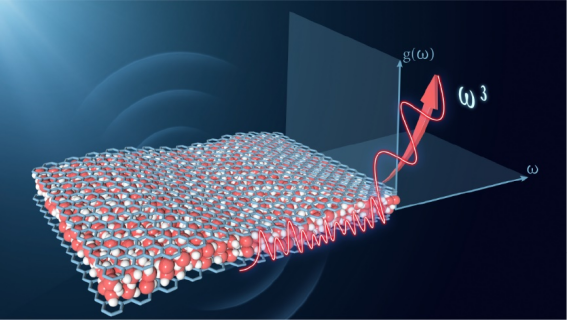← Back
上海交通大学自然院/物理天文学院在Nature communications发表有关准二维受限固体中振动态密度的 ω3标度的最新研究成果
2022年6月
近日,由上海交通大学自然科学研究院/物理与天文学院洪亮教授及Matteo Baggioli教授领导的合作团队发现了在准二维受限固体中低频振动态密度(VDOS)遵循比经典德拜模型更高的标度。其结果发表在《自然 · 通讯》杂志上。

图:准二维受限冰的振动态密度
原子振动,尤其是低频振动,在各种物理、化学和生物系统的功能中起着至关重要的作用,比如介导电子输运,溶剂分子扩散,底物与靶蛋白的结合。110年前,物理学家Peter Debye提出了著名的德拜模型 (Debye model)预测了晶体有序固体振动态密度在低频下的二次幂标度(~ ω^2)以及随之而来的~T^3 的比热变化。该模型很好地描述了晶体体材料的振动性质和比热,并且已经得到了大量的实验结果验证。然而德拜模型能否在各种空间受限的固体中适用,并不清楚。
本工作以非弹性中子散射为实验手段,探究了不同受限尺寸下,氧化石墨烯薄膜夹层中的纳米受限冰的振动态密度变化。团队发现随着受限尺寸的缩小,受限冰的振动态密度的低频标度会从Debye模型的 ω^2 变化到更快增长的 ω^3。全原子分子动力学模拟验证了该实验结果,并且发现无论受限固体是否是晶体都遵守这一标度变化。
通过建立简单的几何模型,团队推导出 ω^3 来自于固体单方向的受限对其相空间的约束。同时该模型还预言标度会重现在一个更高的交叠频率ωX=2πv/L (v为固体中声速,L为受限尺寸),该预言得到分子动力学模拟定量验证。本工作结合了实验,模拟和理论的研究方法,揭示了受限固体低频振动模式的新机制。
本工作近日发表于Nature Communications :
The ω3 scaling of the vibrational density of states in quasi-2D nanoconfined solids | Nature Communications
洪亮课题组博士生余元玺与博士后杨晨星为本文共同第一作者。自然科学研究院/物理与天文学院/张江高等研究院洪亮教授与物理与天文学院维尔切克量子中心Matteo Baggioli教授为本文共同通讯作者。理论模型的提出得到了伦敦玛丽女王大学的Dr. Anthony E. Phillips 和米兰大学的 Dr. Alessio Zaccone的帮助。中子散射实验得到了日本J-PARC的谱仪科学家Dr. Ryoichi Kajimoto, Dr. Mitsutaka Nakamura和澳大利亚ANSTO的谱仪科学家Dr. Dehong Yu的技术支持。本工作得到了国家自然科学基金委、上海市科委、教委以及上海交通大学学生创新中心和上海交通大学高性能计算中心的支持。
An international collaborative research group led by researchers from Shanghai Jiao Tong University (SJTU) discovered that the low-frequency vibrational density of states (VDOS) of quasi-two-dimensional (quasi-2D) confined solids follows a new physical law faster than that in classical Debye’s theory. The results have been published in Nature Communications.
Atomic vibrations play a vital role in various physical, chemical and biological systems, e.g., facilitating transportation of electrons, diffusion of solvent molecules and binding of the ligand with its target protein. 110 years ago, Peter Debye proposed his famous Debye model, which predicted the ~ω^2 low-frequency scaling of the VDOS for ordered crystals and the subsequent ~T^3 low-temperature scaling of specific heat, in agreement with many experimental observations. However, whether the Debye model can be applied to a variety of confined solids remains to be determined.
In this work, inelastic neutron scattering was used to investigate the VDOS of ice nano-confined between graphene oxide membranes at different confinement scales. The team found that the low-frequency scaling of the VDOS of the confined ice varies from the ω^2 Debye law to a faster ω^3 behavior as the confinement length is reduced. All-atom molecular dynamics (MD) simulations have confirmed the experimental results and have shown that the ω^3 scaling appears independently of the crystalline or amorphous nature of the confined ice.
Based on a simple geometric model, the team deduced that the cubic power law arises from the phase space constraints created by confinement. Using the same theoretical framework, the team predicted that the Debye model scaling would reappear at a higher crossover frequency ωX=2πv/L (where v is the speed of sound in the solid and L is the confinement size). MD simulations further verified this prediction. This work combines experimental, simulation and theoretical research methods to provide a new understanding into the study of vibrational properties of confined solids.
The results have been published in Nature Communications:
The ω3 scaling of the vibrational density of states in quasi-2D nanoconfined solids | Nature Communications.
The co-first authors of this article are Ph.D. student Yuanxi Yu and Postdoctoral fellow Chenxing Yang from Prof. Liang Hong’s group. Prof. Matteo Baggioli from Wilczek Quantum Center of School of Physics and Astronomy and Prof. Liang Hong fromSchool of Physics and Astronomy, Institute of Natural Sciences and Zhangjiang Institute For Advanced Study jointly supervised this work as corresponding authors. The theoretical model was developed with the help of Dr. Anthony E. Phillips from Queen Mary University of London and Dr. Alessio Zaccone from University of Milan. The neutron scattering experiments were carried out with the help of Dr. Ryoichi Kajimoto, Dr. Mitsutaka Nakamura in J-PARC (Japan) and Dr. Dehong Yu in ANSTO (Australia). The work was supported by National Natural Science Foundation of China, Shanghai Municipal Science and Technology Major Project, Student Innovation Center and Center for High Performance Computing at SJTU.
